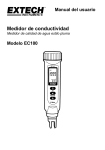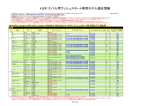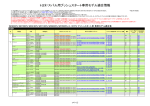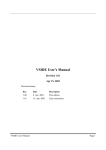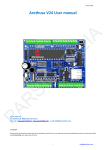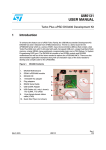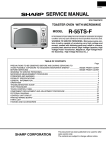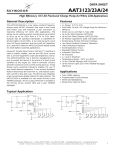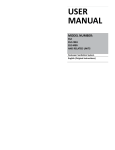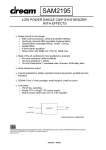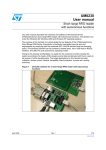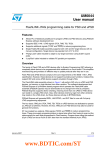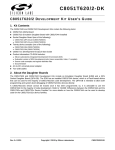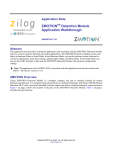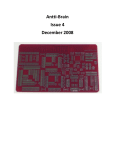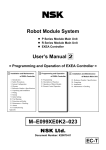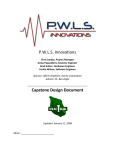Download STEVAL-IFS001V1 evaluation kit with MEMS
Transcript
UM0223 User manual STEVAL-IFS001V1 evaluation kit with MEMS Introduction This user manual gives an overview of the use of STEVAL-IFS001V1 kit with MEMS (MicroElectro-Mechanical System) evaluation board. As shown in the next section, this evaluation board consists of the DK3420 (uPSD evaluation board) and the ST-MEMS-xx-EVAL (MEMS evaluation module). When connected together as an evaluation kit, MEMS applications can be evaluated and measured through a USB connection to a PC. A brief introduction to the MEMS software, MEMS USB Reader 7.x, is also provided. ) s t( MEMS can be used in a variety of vibration sensor and intelligent movement estimator situations, for example: c u d ■ Vibration analysis – Motor control – High buildings ■ Control of position – Stability system for caravans – Stability for cable cars ■ Sport – Sport shoes – Speedometers ■ Automotive – Black box – Intelligent driver sensors – Car alarms ■ Navigation – Dead-reckoning for GPS ■ Logistics – Blackbox for containers (sensoring) ■ Robotics – Control of robot arms (welding robots) ■ Security – Vibration detection (broken window alarm) ) s ( ct e t le o r P o s b O - u d o r P e t e l o s b O April 2006 Rev 1 1/14 www.st.com Contents STEVAL-IFS001V1 Contents 1 Overview of MEMS evaluation boards . . . . . . . . . . . . . . . . . . . . . . . . . . . 3 2 Pin description . . . . . . . . . . . . . . . . . . . . . . . . . . . . . . . . . . . . . . . . . . . . . 6 3 I2C and SPI use . . . . . . . . . . . . . . . . . . . . . . . . . . . . . . . . . . . . . . . . . . . . . 7 4 3.1 I2C and SPI connections . . . . . . . . . . . . . . . . . . . . . . . . . . . . . . . . . . . . . . 7 3.2 Recommendations for I2C use . . . . . . . . . . . . . . . . . . . . . . . . . . . . . . . . . . 8 3.3 Recommendations for SPI use . . . . . . . . . . . . . . . . . . . . . . . . . . . . . . . . . . 8 5 uPSD software use . . . . . . . . . . . . . . . . . . . . . . . . . . . . . . . . . . . . . . . . . . 9 Digital or analog module . . . . . . . . . . . . . . . . . . . . . . . . . . . . . . . . . . . . . . . 9 4.2 LED signalization . . . . . . . . . . . . . . . . . . . . . . . . . . . . . . . . . . . . . . . . . . . . 9 4.3 Selection of operation mode . . . . . . . . . . . . . . . . . . . . . . . . . . . . . . . . . . . . 9 4.4 On-line measurement . . . . . . . . . . . . . . . . . . . . . . . . . . . . . . . . . . . . . . . . 10 4.5 Off-line measurement . . . . . . . . . . . . . . . . . . . . . . . . . . . . . . . . . . . . . . . . 10 4.6 Read out data from Flash . . . . . . . . . . . . . . . . . . . . . . . . . . . . . . . . . . . . . 10 c u d e t le o r P o s b O - MEMS software - MEMS_USB_Reader_7x . . . . . . . . . . . . . . . . . . . . . . 12 5.1 Initial window and features overview . . . . . . . . . . . . . . . . . . . . . . . . . . . . 12 5.2 MEMS values . . . . . . . . . . . . . . . . . . . . . . . . . . . . . . . . . . . . . . . . . . . . . . 12 5.3 Butterworth filters . . . . . . . . . . . . . . . . . . . . . . . . . . . . . . . . . . . . . . . . . . . 13 5.4 FFT analysis . . . . . . . . . . . . . . . . . . . . . . . . . . . . . . . . . . . . . . . . . . . . . . . 13 ) s ( ct u d o r P e t e l o s b O 2/14 ) s t( 4.1 STEVAL-IFS001V1 1 Overview of MEMS evaluation boards Overview of MEMS evaluation boards Figure 1. STEVAL-IFS001V1 c u d This consists of DK3420 and ST-MEMS-XX-EVAL Figure 2. e t le ) s t( o r P DK3420 - USB Demonstration board with µPSD Turbo Plus ) s ( ct o s b O - u d o r P e s b O t e l o For a pin description, see Section 2. Further information is available in the uPSD34xx datasheet and online, from http://www.st.com 3/14 Overview of MEMS evaluation boards Figure 3. STEVAL-IFS001V1 ST-MEMS-DQ-EVAL c u d e t le ) s t( o r P o s b O - The MEMS module ST-MEMS-DQ-EVAL is designed for the evaluation of a MEMS application which can be used in a variety of vibration sensor and intelligent movement estimator situations. ) s ( ct For a pin description, see Section 2. Additionally, a description of I2C and SPI use is provided in Section 3. u d o Additionally, for further information on this module, refer to the user manual UM0152 “MEMS Module STMEMSDQ-EVAL1 Dedicated to uPSD Evaluation Kit DK34XX”. r P e Features include: t e l o ● ● bs O 4/14 LIS3LV02DQ (QFN28) I2C or SPI ● 3x buttons ● 3x LEDs STEVAL-IFS001V1 Figure 4. Overview of MEMS evaluation boards ST-MEMS-AQ-EVAL (check for availability) c u d e t le Components include: ● LIS3L02AQ (QFN44) ● 3x analog outputs ● 3x buttons ● 3x LEDs ) s ( ct ) s t( o r P o s b O - u d o r P e t e l o s b O 5/14 Pin description 2 STEVAL-IFS001V1 Pin description Table 1. DK3420 - USB demonstration board with µPSD Turbo Plus and ST-MEMSDQ-EVAL H1 5V H10 GND PB0 PB2 PB1 PB3 PB6 LED6 PB4 PB5 LED5 PB7 LED7 RESET P1.6 Ain6 BUT6 3.3V P1.7 Ain7 BUT7 P1.5 Ain5 BUT5 P1.4 Ain4 P1.3 Ain3 P1.2 Ain2 P1.1 Ain1 P1.0 Ain0 H1 & H10 connections c u d H3 & H30 connections H3 H30 PC2 P4.6 SDO P4.4 SPC P4.7 CS GND Legend: P4.5 SDI SPC - SPI clock ● SDI - SPI data input (view from uPSD) ● SDO - SPI data output (view from uPSD) ● ● u d o r P e t e l o ● 6/14 b O - AINx - Analog input x CS - SPI chip select UART0out - UART data out UART0in - UART data in SDA - I2C data SCL - I2C clock e t le P3.3 so P4.1 ● ● O P4.3 P4.0 ● ● bs ) s ( ct P4.2 o r P P3.1 UART0 out P3.0 UART0 P3.2 in P3.5 P3.4 ) s t( P3.7 SCL P3.6 SDA GND GND STEVAL-IFS001V1 I2C and SPI use I2C and SPI use Board schematics for ST-MEMS-DQ-EVAL 5 4 3 RDYINT SDA_SDI GND 1 2 3 4 5 6 7 8 9 10 PC2 P4.6 P4.4 P4.2 P4.0 P3.3 P3.1 P3.5 P3.7 GND SDA_SDI SCL_SPC 1 H10 H1 U8 LIS3LV02DQ GND GND PB1 PB3 PB5 PB7 Ai6 Ai7 Ai4 Ai2 Ai0 NC NC NC NC NC NC NC 1 2 3 4 5 6 7 8 9 10 GND 2V4 SCL_SPC GND GND RDYINT 1 2 3 4 5 6 7 NC GND VDD reserved GND RDY/INT NC NC reserved VDD reserved GND CK NC NC SDO SDA/SDI/SDO VDD_IO SCL/SPC CS NC D GND P4.7 P4.5 P4.3 P4.1 P3.0 P3.2 P3.4 P3.6 GND 28 27 26 25 24 23 22 H30 H3 GND CS SDO 2 2V4 GND CK C 1 2 3 4 5 6 7 8 9 10 VUSB PB0 PB2 PB4 PB6 RSTn V3.3 Ai5 Ai3 Ai1 1 2 3 4 5 6 7 8 9 10 D CK PB6 3V3 P15 CON10 CON10 8 SDO 9 SDA_SDI 10 2V4 11 SCL_SPC12 CS 13 14 CON10 CON10 21 20 19 18 17 16 15 PB5 PB7 P16 P17 LE25_TO92 U11 LE25 3V3 3 Vin C2 100nF C Vout 1 2V4 GND Figure 5. C3 100nF 2 3 R35 3V3 2V4 GND 0 3V3 R34 4k7 3V3 R25 330 L7 L6 L5 2V4 C1 100nF 3V3 R17 10k P17 C4 100nF Pr PB5 GND A Title e t le 2 PB6 P15 od B6 GND PB7 uc P16 B7 GND GND ) s t( B 3V3 R16 10k R15 10k 1 3V3 R26 330 1 2V4 3V3 R27 330 B5 GND 2 3V3 1 R36 4k7 SCL_SPC SDA_SDI CS 2 R37 4k7 B A Digital MEMS module Size A Date: 5 4 3 o s b I C and SPI connections O ) s ( t c u d o r P ete Document Number STEVAL-IFS001V1 Friday, March 03, 2006 2 Rev 0.1 Sheet 1 of 1 1 2 3.1 l o s Signal (on MEMS) I2C (on uPSD) SPI (on uPSD) SCL_SPC P3.7 P4.4 SDO NC P4.5 SDA_SDI P3.6 P4.6 CS NC P4.7 b O 7/14 I2C and SPI use STEVAL-IFS001V1 Recommendations for I2C use 3.2 3.3 ● With I2C, the use of R36 & R37 pull-up resistors (4k7) is advised ● The use of resistor R34 (10k) is not normally necessary as uPSD has an internal pullup of around 100k. ● Because SCL_SPC and SDA_SDI are used for I2C and SPI together, care should be taken with the following instructions: – First (important), disable SPI and set the SPI pins as floating inputs – Set P4.7 (CS) as GPIO output and write ‘1’ to activate I2C on the MEMS chip – Enable I2C on your micro and start the communication Recommendations for SPI use ● With SPI, the use of resistors R36, R37 is NOT advised ● The use of resistor R34 (10k) is not normally necessary as uPSD has an internal pullup of around 100k. ● Because SCL_SPC and SDA_SDI are used for I2C and SPI together, care should be taken with the following instructions: c u d – First (important), disable I2C and set the I2C pins as floating inputs – Activate your SPI. P4.7 is a part of SPI and should be ‘0’, otherwise set P4.7 (CS) as GPIO output and write ‘0’ directly. This instructs the MEMS chip to use SPI – Start the communication ) s ( ct u d o r P e t e l o s b O 8/14 ) s t( o s b O - e t le o r P STEVAL-IFS001V1 uPSD software use 4 uPSD software use 4.1 Digital or analog module The program automatically detects whether a module is digital or analog. The recognition is based on the value on pin P3.3. A digital module has this pin unconnected which is the same as logic ‘1’ because of an internal uPSD pull-up. Analog modules must employ a pull-down resistor to enable the detection of logic ‘0’. 4.2 LED signalization ● LED5 (green) blinking Data is being read. Digital modules are using I2C, analog modules are using ADC. ● LED6 (yellow) blinking This indicates USB communication, data is being sent. ● LED7 (red) blinking c u d The program is running, this led is toggled in main. ) s t( Immediately after the module is plugged in, all LEDs are lit while initialization is in process. When uPSD, the peripherals (I2C,ADC, etc) and MEMS are initialized, the LEDs are turned off. Immediately following this, the main starts and LED7 blinks. ● 4.3 e t le o r P If LED7 doesn't start blinking, the initialization will have failed. a) Check hardware b) Try to restart the PC c) Re-program uPSD d) If still not working, contact support ) s ( ct o s b O - Selection of operation mode u d o During the initialization an operation mode can be selected by pressing buttons: ● no button is pressed r P e On-line measurement (default) ● t e l o bs O Note: ● ● BUT5 is pressed Off-line measurement (it erases the Flash for new measurements which takes around 5s for the 256KB flash) BUT6 is pressed Read out data from Flash (useful after the off-line measurement) BUT7 is pressed No effect. Press the button first and then plug the module into the USB. 9/14 uPSD software use 4.4 STEVAL-IFS001V1 On-line measurement During on-line measurement, data is read from MEMS and sent via USB to the PC. Logically, all three LEDs should blink. In this mode, the buttons have the following meanings: ● no button is pressed uPSD sends data from MEMS to the PC (a packet with MEMS data) ● BUT5 is pressed No effect. ● BUT6 is pressed No effect. ● BUT7 is pressed In the case of digital MEMS, uPSD reads its registers and sends this information via USB (a packet with registers) 4.5 Off-line measurement Ready to start the measurement. Normally LED7 blinks. ● c u d no button is pressed No effect. ● BUT5 is pressed Pause/Stop measurement. ● e t le BUT6 is pressed ) s t( o r P Start measurement, LED5 blinks to indicate data is being read and stored (it stops automatically when the Flash is full). ● BUT7 is pressed o s b O - If measurements have not started, the sample frequency can be changed. Possible frequencies are 40 or 160 Hz. The selection is indicated by the LED7 blinking speed. Off-line measure time uc 128KB (uPSD3433) (t s) od 256KB (uPSD3434) 4.6 r P e @40Hz @160Hz 576s 136s 1092s 273s Read out data from Flash t e l o Ready to start sending data stored in Flash via USB. Normally LED7 is blinking. s b O 10/14 ● ● no button is pressed No effect BUT5 is pressed Start sending data. uPSD sends data from Flash and LED6 blinks (a packet with MEMS data). It reads the entire Flash. Any part which doesn't contain relevant MEMS data you will get 0xFF. After the end of the Flash range, 0xFF will also be sent. 0xFF STEVAL-IFS001V1 uPSD software use values translate as <-1,-1,-1> readings on the PC MEMS USB Reader, which should be considered to detect both false readings and end of Flash data. ● BUT6 is pressed No effect. ● BUT7 is pressed No effect. c u d e t le ) s ( ct ) s t( o r P o s b O - u d o r P e t e l o s b O 11/14 MEMS software - MEMS_USB_Reader_7x STEVAL-IFS001V1 5 MEMS software - MEMS_USB_Reader_7x 5.1 Initial window and features overview Figure 6. Screenshot of initial screen of MEMS USB Reader 7.1 Main features available in the MEMS USB Reader include: 5.2 ● MEMS values in time graph ● Butterworth filters ● FFT analysis e t le MEMS values Figure 7. c u d ) s t( o r P o s b O - Screenshot showing MEMS values in time graph ) s ( ct u d o r P e t e l o Paste from clipboard into Excel s b O Copy data to clipboard 12/14 STEVAL-IFS001V1 MEMS software - MEMS_USB_Reader_7x Use the MEMS Values screen to: 5.3 ● Copy data into the Excel directly via clipboard ● Copy the graphic figure (graph) as a metafile via clipboard ● Save data into a CSV file Butterworth filters Figure 8. Screenshot of the filtering window with Butterworth filter options c u d Filtering options include: 5.4 e t le o r P ● Butterworth low-pass & hi-pass filters order 1-4 ● Butterworth band pass filter order 1 ● It's possible to hide the axis (currently, only the Y-Axis is shown) FFT analysis Figure 9. ) s ( ct ) s t( o s b O - Screenshot of FFT analysis u d o r P e t e l o s b O FFT (Fast Fourier Transform) analysis features and options include: ● FFT for 16, 32, 64, 128 samples ● Allows FFT zoom (filling with zeros) ● Allows to change FFT overlap ● Copy of the figure to clipboard as a metafile 13/14 STEVAL-IFS001V1 Please Read Carefully: Information in this document is provided solely in connection with ST products. STMicroelectronics NV and its subsidiaries (“ST”) reserve the right to make changes, corrections, modifications or improvements, to this document, and the products and services described herein at any time, without notice. All ST products are sold pursuant to ST’s terms and conditions of sale. c u d ) s t( Purchasers are solely responsible for the choice, selection and use of the ST products and services described herein, and ST assumes no liability whatsoever relating to the choice, selection or use of the ST products and services described herein. o r P No license, express or implied, by estoppel or otherwise, to any intellectual property rights is granted under this document. If any part of this document refers to any third party products or services it shall not be deemed a license grant by ST for the use of such third party products or services, or any intellectual property contained therein or considered as a warranty covering the use in any manner whatsoever of such third party products or services or any intellectual property contained therein. e t le o s b O - UNLESS OTHERWISE SET FORTH IN ST’S TERMS AND CONDITIONS OF SALE ST DISCLAIMS ANY EXPRESS OR IMPLIED WARRANTY WITH RESPECT TO THE USE AND/OR SALE OF ST PRODUCTS INCLUDING WITHOUT LIMITATION IMPLIED WARRANTIES OF MERCHANTABILITY, FITNESS FOR A PARTICULAR PURPOSE (AND THEIR EQUIVALENTS UNDER THE LAWS OF ANY JURISDICTION), OR INFRINGEMENT OF ANY PATENT, COPYRIGHT OR OTHER INTELLECTUAL PROPERTY RIGHT. UNLESS EXPRESSLY APPROVED IN WRITING BY AN AUTHORIZE REPRESENTATIVE OF ST, ST PRODUCTS ARE NOT DESIGNED, AUTHORIZED OR WARRANTED FOR USE IN MILITARY, AIR CRAFT, SPACE, LIFE SAVING, OR LIFE SUSTAINING APPLICATIONS, NOR IN PRODUCTS OR SYSTEMS, WHERE FAILURE OR MALFUNCTION MAY RESULT IN PERSONAL INJURY, DEATH, OR SEVERE PROPERTY OR ENVIRONMENTAL DAMAGE. ) s ( ct u d o Resale of ST products with provisions different from the statements and/or technical features set forth in this document shall immediately void any warranty granted by ST for the ST product or service described herein and shall not create or extend in any manner whatsoever, any liability of ST. r P e t e l o s b O ST and the ST logo are trademarks or registered trademarks of ST in various countries. Information in this document supersedes and replaces all information previously supplied. The ST logo is a registered trademark of STMicroelectronics. All other names are the property of their respective owners. © 2006 STMicroelectronics - All rights reserved STMicroelectronics group of companies Australia - Belgium - Brazil - Canada - China - Czech Republic - Finland - France - Germany - Hong Kong - India - Israel - Italy - Japan Malaysia - Malta - Morocco - Singapore - Spain - Sweden - Switzerland - United Kingdom - United States of America www.st.com 14/14














